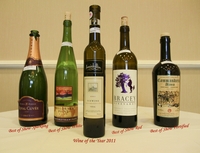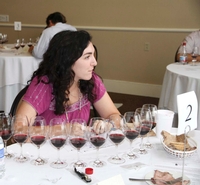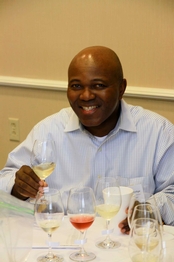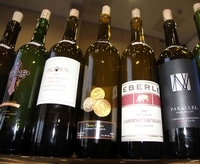The Sommelier Challenge International Wine Competition ended on a sweet note earlier this month in San Diego as the distinguished panel of wine professionals voted an ice wine from Canada’s Niagara Peninsula Wine of the Year at the annual event.
 Though it faced stiff opposition in the championship round from an array of impressive wines from a number of the world’s most well-regarded producers, the Inniskillin 2007 Vidal Ice Wine ($60) narrowly prevailed.
Though it faced stiff opposition in the championship round from an array of impressive wines from a number of the world’s most well-regarded producers, the Inniskillin 2007 Vidal Ice Wine ($60) narrowly prevailed.
Ice wine, for the uninitiated, is a wine that is made from grapes picked after they’ve frozen on the vine, a technique that was originally perfected in Germany. The result is a wine that is very concentrated and intensely sweet. Ice wines are typically served after dinner with cheeses, or during the course of a meal with foie gras.
Ice wines are expensive to produce because yields are extremely low, which makes them a rare and expensive treat. Inniskillin entered three ice wines, and all three were voted Platinum awards and pushed forward into the championship round.
Sommelier Challenge III brought together a dozen sommeliers from New York, San Francisco, Napa Valley, Los Angeles and San Diego to judge 657 entries from 17 countries.
 Among the top winners was perennial competition favorite Gloria Ferrer, which aced the vote for Best of Show sparkling wine with its 2002 Royal Cuvee Brut ($32), a wine that has had an impressive run in major wine competitions over the past two years. Gloria Ferrer also saw its 2008 Estate Chardonnay, Carneros ($18), advance to the finals.
Among the top winners was perennial competition favorite Gloria Ferrer, which aced the vote for Best of Show sparkling wine with its 2002 Royal Cuvee Brut ($32), a wine that has had an impressive run in major wine competitions over the past two years. Gloria Ferrer also saw its 2008 Estate Chardonnay, Carneros ($18), advance to the finals.
Best of Show red wine was awarded to Bracey Vineyards for its 2006 Howell Mountain, Napa Valley Cabernet Sauvignon ($65). To win Best Red, the Bracey had to survive a runoff that included Chateau St. Jean’s 2007 Cinq Cepages, Sonoma County ($75), ColSolare 2007 Red Wine, Columbia Valley ($75) and Domaine Carneros 2008 Pinot Noir, The Famous Gate, Carneros ($68).
The Cinq Cepages and ColSolare had to settle for a tie as Best Bordeaux Blend, and Domaine’s Carneros’ The Famous Gate was the runaway winner as Best Pinot Noir.
Voting for Best of Show white wine produced a value gem from New York’s Finger Lakes region, with a Sheldrake Point Vineyard 2010 Gewurztraminer ($15) emerging as the winner. This was a beautifully balanced white from perhaps America’s premier growing region for this particular grape variety.
Sheldrake Point was a narrow winner in the vote for Best White over the Rodney Strong Vineyards 2009 Chardonnay Reserve, Russian River Valley ($35).
 The category for Best Fortified also produced a very close vote, with the Commandaria Alasia, Cyprus ($23) prevailing by one vote over a beautiful sherry from Spain’s Gonzalez Byass, the Solera 1847 Oloroso Dulce, Jerez ($20). The Cypriot winner was made in a sweet sherry style.
The category for Best Fortified also produced a very close vote, with the Commandaria Alasia, Cyprus ($23) prevailing by one vote over a beautiful sherry from Spain’s Gonzalez Byass, the Solera 1847 Oloroso Dulce, Jerez ($20). The Cypriot winner was made in a sweet sherry style.
There were numerous other outstanding performances. I’ve singled out some of the more interesting winners:
Eberle Winery of Paso Robles was named Winery of the Year. Eberle entered 14 wines and medaled with 13 of them, including a Platinum award for its 2007 Estate Cabernet Sauvignon ($34). As director, I evaluate the results and select the top performance based upon consistency and quality of awards. Besides the Platinum, Eberle earned Gold awards for its 2008 Cabernet Sauvignon/Syrah ($29), its 2007 Reserve Cabernet Sauvignon ($75), its 2009 Steinbeck Vineyard Syrah ($21) and its 2010 Muscat Canelli ($14).
Barboursville Vineyards has long been among the top wineries in Virginia, and that fact was evident by the number of awards — six — that Barboursville racked up, as well as the quality of the awards. This sterling example of the potential for Virginia wine won four Gold awards: 2007 Octagon ($39.99), 2009 Cabernet Franc Reserve ($22.99), 2010 Viognier Reserve ($21.99) and 2010 Vermentino Reserve ($21.99). All of the Barboursville winners carry a Virginia appellation.
Jefferson Vineyards is another superb Virginia winery, and it’s located on the site of Thomas Jefferson’s original vineyard plantings. Jefferson scored Gold awards with its 2010 Chardonnay, Reserve Monticello ($21.95) and its 2010 Pinot Gris, Virginia ($18.95). They say Virginia is for wine lovers. Now I believe it.
 Castello Banfi of Brunello di Montalcino fame and its sister property in the Chianti district of Tuscany swept eight awards, and six of those were Gold. Castello Banfi won Gold with the 2007 Belnero Proprietor’s Reserve, Toscana IGT ($39), the 2006 Brunello di Montalcino DOCG ($55) and the 2009 San Angelo Pinot Grigio, Toscana IGT ($17). The Chianti wing of Banfi took Gold awards for its 2009 Chianti DOCG Superiore ($11), the 2007 Chianti Classico Riserva DOCG ($18) and the 2008 Centine Rosso, Toscana IGT ($11).
Castello Banfi of Brunello di Montalcino fame and its sister property in the Chianti district of Tuscany swept eight awards, and six of those were Gold. Castello Banfi won Gold with the 2007 Belnero Proprietor’s Reserve, Toscana IGT ($39), the 2006 Brunello di Montalcino DOCG ($55) and the 2009 San Angelo Pinot Grigio, Toscana IGT ($17). The Chianti wing of Banfi took Gold awards for its 2009 Chianti DOCG Superiore ($11), the 2007 Chianti Classico Riserva DOCG ($18) and the 2008 Centine Rosso, Toscana IGT ($11).
Bouchaine Vineyards of the Napa Valley’s Carneros district only entered four wines but claimed two Platinums with its 2008 Estate Pinot Noir ($30) and its 2009 Estate Chardonnay ($25). The 2010 Bouche d’Or Chardonnay ($30) won Gold.
Winery at Holy Cross Abbey acquitted itself well, representing the growing Colorado wine industry with five awards, including Platinum for a 2009 Cabernet Franc ($29) and a 2008 Syrah Reserve ($30). Both of those wines carry the Colorado appellation on the label.
Rodney Strong Vineyards of Sonoma County was among the first California wineries to take chardonnay seriously and plant it copiously. As a result, chardonnay has always been a Rodney Strong strength. That manifest itself in the Best Chardonnay award with its 2009 Chardonnay Reserve, Russian River Valley ($35). It was a very good weekend for Rodney Strong, winning 10 medals overall.
Parallel Vineyards of the Napa Valley entered two wines and walked off with Platinum and Gold for its two stellar Napa Valley Cabernet Sauvignons, the Estate ($125) and the Napa Valley ($55). The winemaker is the renowned Philippe Melka.
Complete results of the 2011 Sommelier Challenge, as well as the names and background of the participating sommeliers, can be found at SommelierChallenge.com.
8
